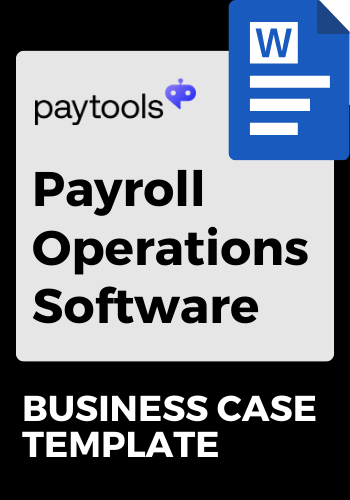Payroll operations have evolved dramatically in the past 20 years, yet the tools used to manage payroll processes remain outdated. The reliance on spreadsheets, email approvals and static documents leads to inefficiencies, compliance risks and an overburdened payroll team.
We’re now seeing that expectations on payroll governance and transparency have never been higher. Payroll is too complex to effectively manage using siloed checklists, calendars and manual processes.
This article provides a framework for building a business case for payroll operations software, demonstrating the return on investment (ROI) of implementing a platform such as Paytools.
We’ve also created a business case template in Word to help you get started.
Why is it the Right Time to Invest in Payroll Operations Software?
• Regulatory pressure is increasing: Payroll legislation and Enterprise Agreements are changing at an unprecedented pace.
• Payroll industry burnout: Staff shortages and high turnover rates create operational risk.
• Reputational and financial risk: Non-compliance leads to significant fines and negative publicity.
• Payroll governance expectations are at an all-time high: Every payroll function is now expected to demonstrate and develop its controls, structures and practices.
The Current State of Payroll
EXTERNAL ENVIRONMENT FACTORS
- Complex legislative landscape
- Enterprise Agreement, modern award changes
- High volume of legislative updates
- Payroll staff shortages and high turnover
- According to the 2025 Payroll Industry Report, 19.2% of respondents said that payroll team resourcing and/or lack of training are a major challenge facing payroll. This is especially true for payroll professionals operating in small teams, which often leads to burnout and increased error rates.
- Increased compliance scrutiny
- Risk of non-compliance, fines, and reputational damage
INTERNAL FACTORS
Key Payroll Challenges
| Inefficient documentation | Payroll processes are static documents, hard to maintain and difficult to operationalise |
| Manual processing bottlenecks | Payroll staff rely on email, spreadsheets and outdated approval processes |
| Payroll knowledge siloed among key individuals | Heavy reliance on key personnel increases risk |
| Tracking payroll obligations is challenging | Deadlines, reviews and compliance requirements are difficult to monitor |
| Lack of real-time visibility | Payroll operations data is scattered across various tools, making reporting difficult |
| Inadequate tools | Relying on Excel, Word, Outlook and shared drives is inefficient and high-risk |
Proposal: A Payroll Operations Platform
WHAT IS PAYROLL OPERATIONS SOFTWARE?
-
- Centralised payroll calendar: Tracks all payroll activities, ensuring deadlines are met.
- Operationalised processes: Ensures payroll tasks follow best practices with documented workflows.
- Built-in controls & proof of work: Reduces audit risk and enhances compliance.
- Risk management & monitoring: Provides real-time visibility into payroll performance.
- Reporting & analytics: Offers dashboards and insights to optimise payroll efficiency.
- Team training & process continuity: Reduces dependency on key individuals and supports team upskilling.
KEY BENEFITS OF PAYROLL OPERATIONS SOFTWARE
✅ Operational Efficiencies
- Standardised payroll processes across the team
- Reduced manual activities and errors
- Clear division of responsibilities
- Faster payroll issue resolution
- Streamlined approvals and real-time payroll tracking
- Improved team communication
✅ Enhanced Governance & Compliance
- Transparent tracking of payroll obligations and compliance requirements
- Clear audit trails for proof of work
- Risk identification and mitigation measures
- Documentation of roles, responsibilities and process ownership
- Version control for payroll procedures to prevent duplication or outdated practices
ROI of Payroll Operations Software
📈 Projected Cost Savings & Productivity Gains
-
- Onboarding & training: Faster ramp-up time for new payroll team members
- Time savings: Reduced time spent searching for payroll records, approvals, and historical data
- Compliance efficiencies: Streamlined audit responses, reducing time spent on regulatory reviews
- Issue resolution: Faster identification and resolution of recurring payroll errors
- Cross-training & staff flexibility: Ability to rotate payroll duties without risk of process breakdown
Case Studies: Organisations Using Paytools
|
🏢 Cerebral Palsy Alliance Healthcare: 3,000 employees, 11 payroll staff
|
|
🏢 Avivo Healthcare: 1,300 employees, 4 payroll staff
|
|
🏢 University of Sydney: 25,000 employees, 20 payroll staff
|
|
🏢 Volvo: 1,600 employees, 3 payroll staff
|
|
🏢 Large Corporate: 4,000 employees, 20 payroll staff
|
Transitioning Payroll Systems? Why You Need Paytools First
🚀 Key Benefits Before a System Migration
-
- Document existing processes before payroll transition begins
- Improve visibility of payroll operations during system migration
- Ensure knowledge retention and prevent disruptions
- Use Paytools to refine and optimise payroll processes pre and post-migration
- SI partners can set up workflows directly in Paytools for a seamless transition
Conclusion
Payroll operations are too critical to be managed with outdated tools. A centralised payroll operations platform improves efficiency, reduces risk and ensures payroll compliance.
NEXT STEPS 👣
📌 Book a demo of Paytools to see how it can improve payroll operations for your organisation.
📌 Download the business case template and add your company-specific pain points and estimated ROI.
📌 Present to leadership to secure buy-in and budget approval.
DOWNLOAD THE BUSINESS CASE TEMPLATE
Complete this form to download [Word doc]:




